tow SKODA ROOMSTER 2007 1.G User Guide
[x] Cancel search | Manufacturer: SKODA, Model Year: 2007, Model line: ROOMSTER, Model: SKODA ROOMSTER 2007 1.GPages: 248, PDF Size: 46.44 MB
Page 54 of 248
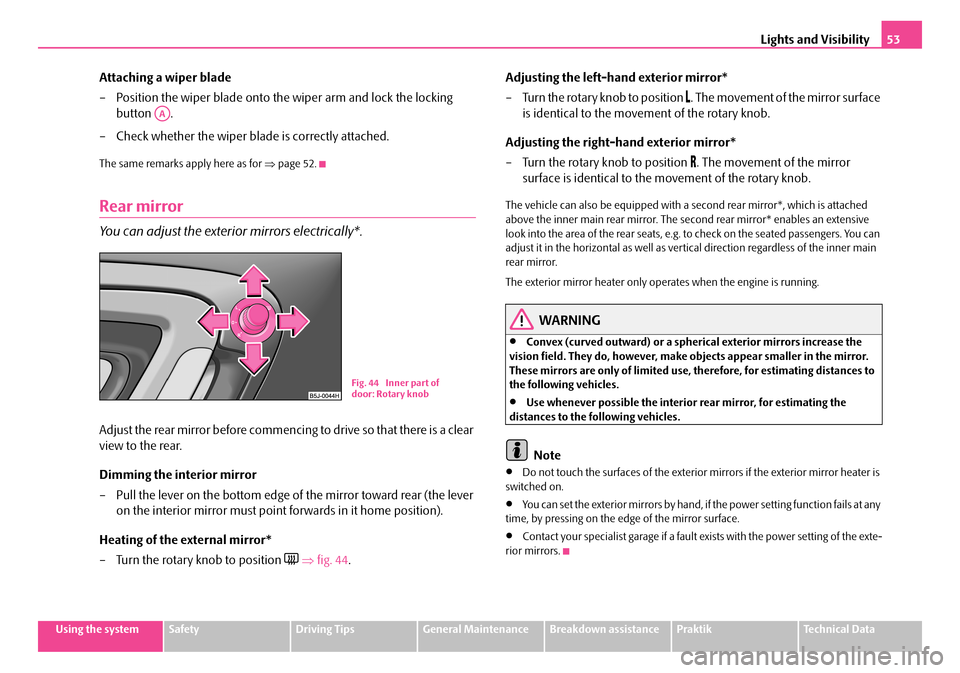
Lights and Visibility53
Using the systemSafetyDriving TipsGeneral MaintenanceBreakdown assistancePraktikTechnical Data
Attaching a wiper blade
– Position the wiper blade onto th e wiper arm and lock the locking
button .
– Check whether the wiper blade is correctly attached.
The same remarks apply here as for ⇒page 52.
Rear mirror
You can adjust the exterior mirrors electrically*.
Adjust the rear mirror before commencing to drive so that there is a clear
view to the rear.
Dimming the interior mirror
– Pull the lever on the bottom edge of the mirror toward rear (the lever
on the interior mirror must point forwards in it home position).
Heating of the external mirror*
– Turn the rotary knob to position ⇒fig. 44.
Adjusting the left-hand exterior mirror*
– Turn the rotary knob to position . The movement of the mirror surface
is identical to the movement of the rotary knob.
Adjusting the right-hand exterior mirror*
– Turn the rotary knob to position . The movement of the mirror
surface is identical to the movement of the rotary knob.
The vehicle can also be equipped with a se cond rear mirror*, which is attached above the inner main rear mirror. The second rear mirror* enables an extensive look into the area of the rear seats, e.g. to check on the seated passengers. You can adjust it in the horizontal as well as vertical direction regardless of the inner main rear mirror.
The exterior mirror heater only operates when the engine is running.
WARNING
•Convex (curved outward) or a spherical exterior mirrors increase the vision field. They do, however, make objects appear smaller in the mirror. These mirrors are only of limited use, therefore, for estimating distances to the following vehicles.
•Use whenever possible the interior rear mirror, for estimating the distances to the following vehicles.
Note
•Do not touch the surfaces of the exterior mirrors if the exterior mirror heater is switched on.
•You can set the exterior mirrors by hand, if the power setting function fails at any time, by pressing on the ed ge of the mirror surface.
•Contact your specialist garage if a fault exists with the power setting of the exte- rior mirrors.
AA
Fig. 44 Inner part of door: Rotary knob
NKO A05R 20 MR08.book Page 53 Wednesday, March 28, 2007 9:42 AM
Page 55 of 248
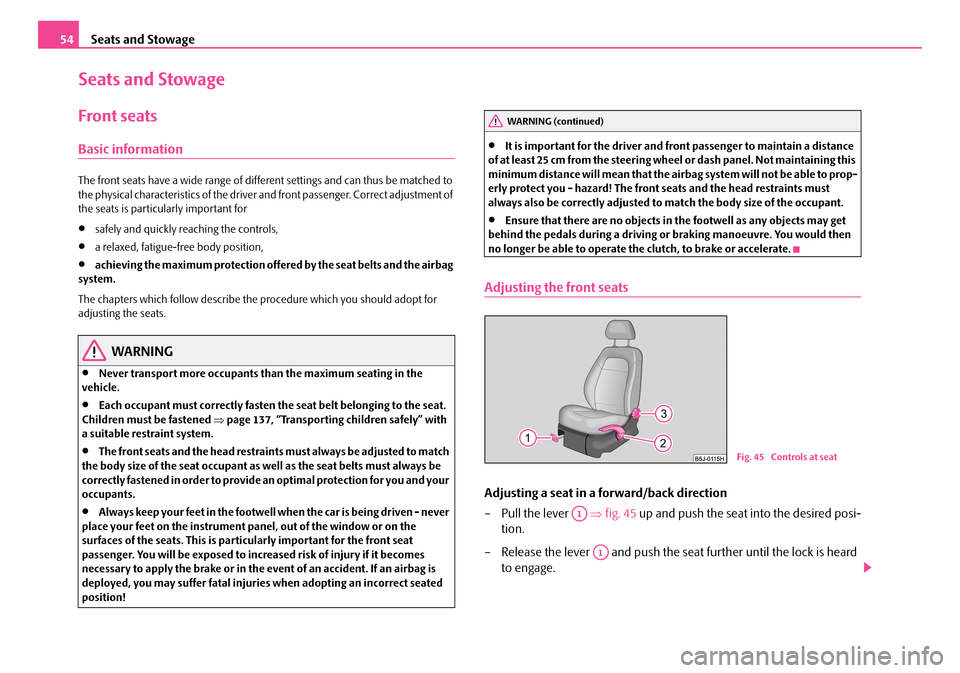
Seats and Stowage54
Seats and Stowage
Front seats
Basic information
The front seats have a wide range of different settings and can thus be matched to the physical characteristics of the driver and front passenger. Correct adjustment of the seats is particularly important for
•safely and quickly reaching the controls,
•a relaxed, fatigue-free body position,
•achieving the maximum protection offere d by the seat belts and the airbag system.
The chapters which follow describe the procedure which you should adopt for adjusting the seats.
WARNING
•Never transport more occupants than the maximum seating in the vehicle.
•Each occupant must correctly fasten the seat belt belonging to the seat. Children must be fastened ⇒page 137, “Transporting children safely” with a suitable restraint system.
•The front seats and the head restraints must always be adjusted to match the body size of the seat occupant as well as the seat belts must always be correctly fastened in order to provide an optimal protection for you and your occupants.
•Always keep your feet in the footwell when the car is being driven - never place your feet on the instrument panel, out of the window or on the surfaces of the seats. This is particularly important for the front seat passenger. You will be exposed to increased risk of injury if it becomes necessary to apply the brake or in the event of an accident. If an airbag is deployed, you may suffer fatal injuries when adopting an incorrect seated position!
•It is important for the driver and front passenger to maintain a distance of at least 25 cm from th e steering wheel or dash panel. Not maintaining this minimum distance will mean that the airbag system will not be able to prop- erly protect you - hazard! The front seats and the head restraints must always also be correctly adjusted to match the body size of the occupant.
•Ensure that there are no objects in the footwell as any objects may get behind the pedals during a driving or braking manoeuvre. You would then no longer be able to operate the clutch, to brake or accelerate.
Adjusting the front seats
Adjusting a seat in a forward/back direction
– Pull the lever ⇒fig. 45 up and push the seat into the desired posi-
tion.
– Release the lever and push the seat further until the lock is heard
to engage.
WARNING (continued)
Fig. 45 Controls at seat
A1
A1
NKO A05R 20 MR08.book Page 54 Wednesday, March 28, 2007 9:42 AM
Page 56 of 248
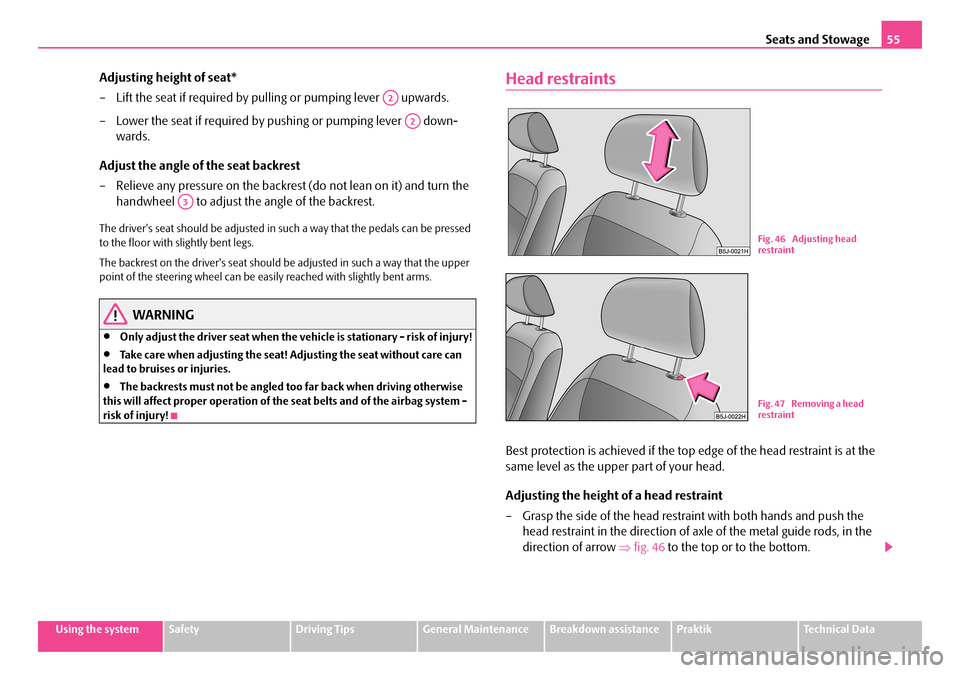
Seats and Stowage55
Using the systemSafetyDriving TipsGeneral MaintenanceBreakdown assistancePraktikTechnical Data
Adjusting height of seat*
– Lift the seat if required by pulling or pumping lever upwards.
– Lower the seat if required by pushing or pumping lever down-
wards.
Adjust the angle of the seat backrest
– Relieve any pressure on the backrest (do not lean on it) and turn the
handwheel to adjust the angle of the backrest.
The driver's seat should be adjusted in such a way that the pedals can be pressed to the floor with slightly bent legs.
The backrest on the driver's seat should be adjusted in such a way that the upper point of the steering wheel can be easi ly reached with slightly bent arms.
WARNING
•Only adjust the driver seat when the vehicle is stationary - risk of injury!
•Take care when adjusting the seat! Adjusting the seat without care can lead to bruises or injuries.
•The backrests must not be angled too far back when driving otherwise this will affect proper operation of the seat belts and of the airbag system - risk of injury!
Head restraints
Best protection is achieved if the top edge of the head restraint is at the
same level as the uppe r part of your head.
Adjusting the height of a head restraint
– Grasp the side of the head restraint with both hands and push the
head restraint in the direction of axle of the metal guide rods, in the
direction of arrow ⇒fig. 46 to the top or to the bottom.
A2
A2
A3
Fig. 46 Adjusting head restraint
Fig. 47 Removing a head restraint
NKO A05R 20 MR08.book Page 55 Wednesday, March 28, 2007 9:42 AM
Page 57 of 248
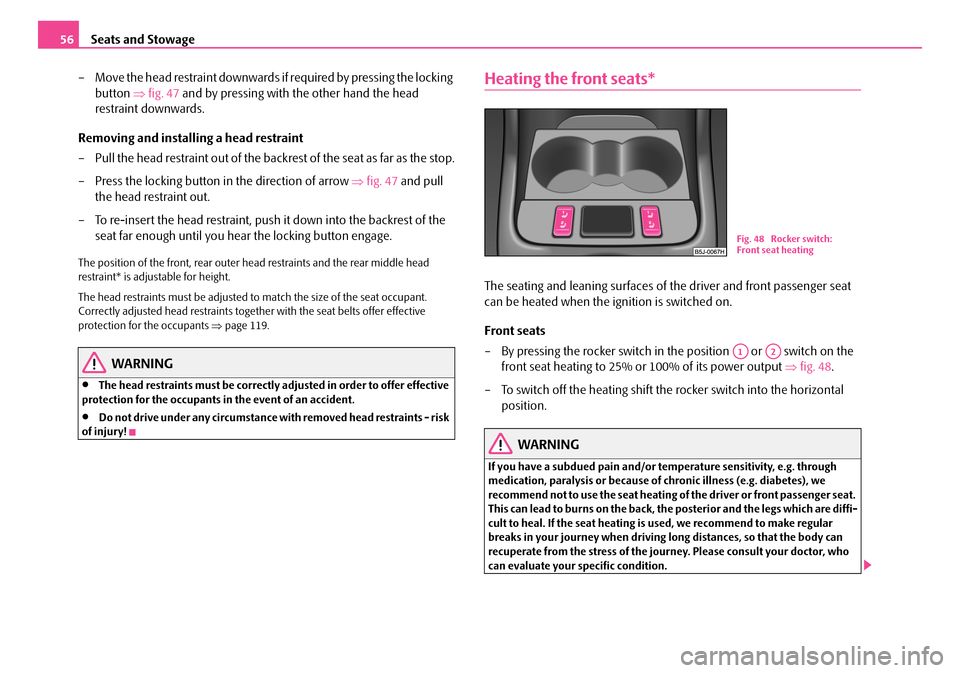
Seats and Stowage56
– Move the head restraint downwards if required by pressing the locking
button ⇒fig. 47 and by pressing with the other hand the head
restraint downwards.
Removing and installing a head restraint
– Pull the head restraint out of the backrest of the seat as far as the stop.
– Press the locking button in the direction of arrow ⇒fig. 47 and pull
the head restraint out.
– To re-insert the head restraint, push it down into the backrest of the
seat far enough until you hear the locking button engage.
The position of the front, rear outer head restraints and the rear middle head restraint* is adjustable for height.
The head restraints must be adjusted to match the size of the seat occupant. Correctly adjusted head restraints togeth er with the seat belts offer effective protection for the occupants ⇒page 119.
WARNING
•The head restraints must be correctly adjusted in order to offer effective protection for the occupants in the event of an accident.
•Do not drive under any circumstance with removed head restraints - risk of injury!
Heating the front seats*
The seating and leaning surfaces of the driver and front passenger seat
can be heated when the ignition is switched on.
Front seats
– By pressing the rocker switch in the position or switch on the
front seat heating to 25% or 100% of its power output ⇒fig. 48.
– To switch off the heating shift the rocker switch into the horizontal
position.
WARNING
If you have a subdued pain and/or temperature sensitivity, e.g. through medication, paralysis or because of ch ronic illness (e.g. diabetes), we recommend not to use the seat heating of the driver or front passenger seat. This can lead to burns on the back, th e posterior and the legs which are diffi- cult to heal. If the seat heating is used, we recommend to make regular breaks in your journey when driving long distances, so that the body can recuperate from the stress of the journey. Please consult your doctor, who can evaluate your specific condition.
Fig. 48 Rocker switch: Front seat heating
A1A2
NKO A05R 20 MR08.book Page 56 Wednesday, March 28, 2007 9:42 AM
Page 58 of 248
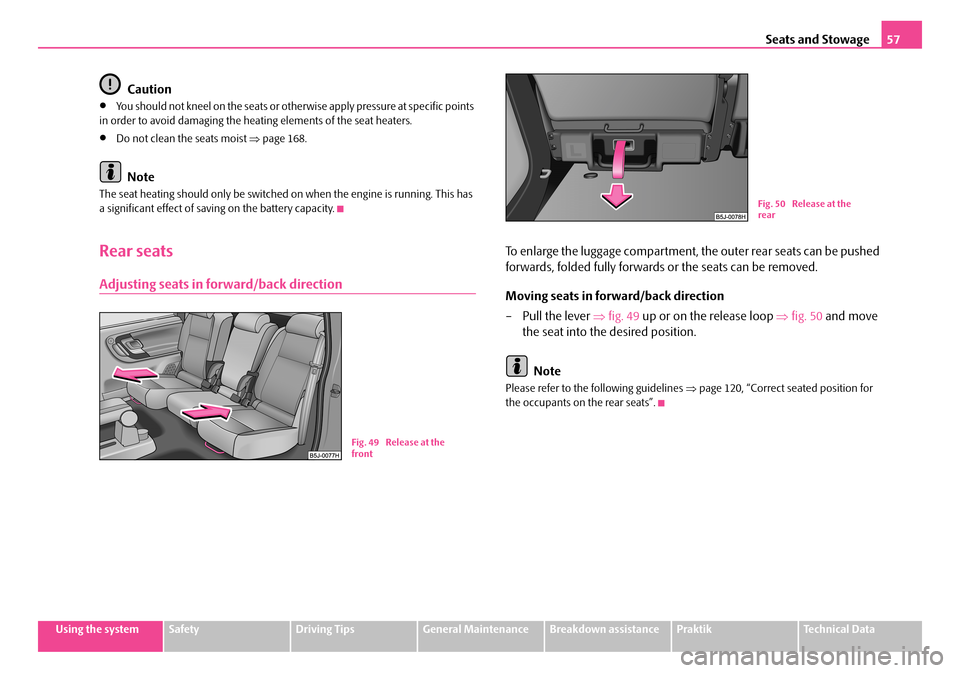
Seats and Stowage57
Using the systemSafetyDriving TipsGeneral MaintenanceBreakdown assistancePraktikTechnical Data
Caution
•You should not kneel on the seats or otherwise apply pressure at specific points in order to avoid damaging the heating elements of the seat heaters.
•Do not clean the seats moist ⇒page 168.
Note
The seat heating should only be switched on when the engine is running. This has a significant effect of saving on the battery capacity.
Rear seats
Adjusting seats in forward/back direction
To enlarge the luggage compartment, the outer rear seats can be pushed
forwards, folded fully forwards or the seats can be removed.
Moving seats in forward/back direction
–Pull the lever ⇒fig. 49 up or on the release loop ⇒fig. 50 and move
the seat into the desired position.
Note
Please refer to the following guidelines ⇒page 120, “Correct seated position for the occupants on the rear seats”.
Fig. 49 Release at the front
Fig. 50 Release at the rear
NKO A05R 20 MR08.book Page 57 Wednesday, March 28, 2007 9:42 AM
Page 59 of 248
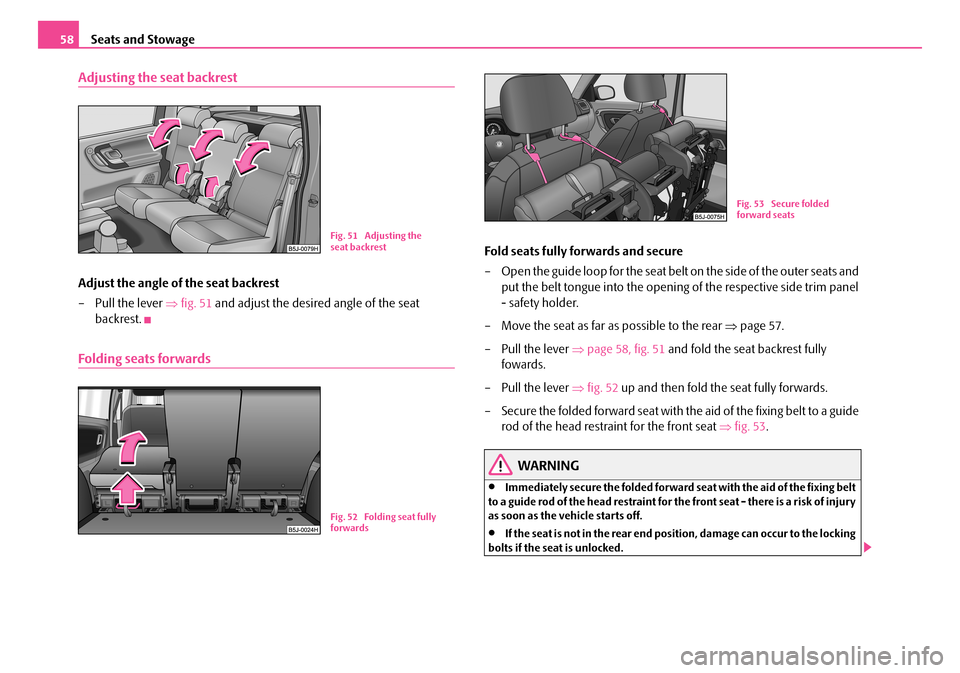
Seats and Stowage58
Adjusting the seat backrest
Adjust the angle of the seat backrest
– Pull the lever ⇒fig. 51 and adjust the desired angle of the seat
backrest.
Folding seats forwards
Fold seats fully forwards and secure
– Open the guide loop for the seat belt on the side of the outer seats and
put the belt tongue into the opening of the respective side trim panel
- safety holder.
– Move the seat as far as possible to the rear ⇒page 57.
– Pull the lever ⇒page 58, fig. 51 and fold the seat backrest fully
fowards.
– Pull the lever ⇒fig. 52 up and then fold the seat fully forwards.
– Secure the folded forward seat with the aid of the fixing belt to a guide
rod of the head restraint for the front seat ⇒fig. 53.
WARNING
•Immediately secure the folded forward seat with the aid of the fixing belt to a guide rod of the head restraint for the front seat - there is a risk of injury as soon as the vehicle starts off.
•If the seat is not in the rear end po sition, damage can occur to the locking bolts if the seat is unlocked.
Fig. 51 Adjusting the seat backrest
Fig. 52 Folding seat fully forwards
Fig. 53 Secure folded forward seats
NKO A05R 20 MR08.book Page 58 Wednesday, March 28, 2007 9:42 AM
Page 60 of 248
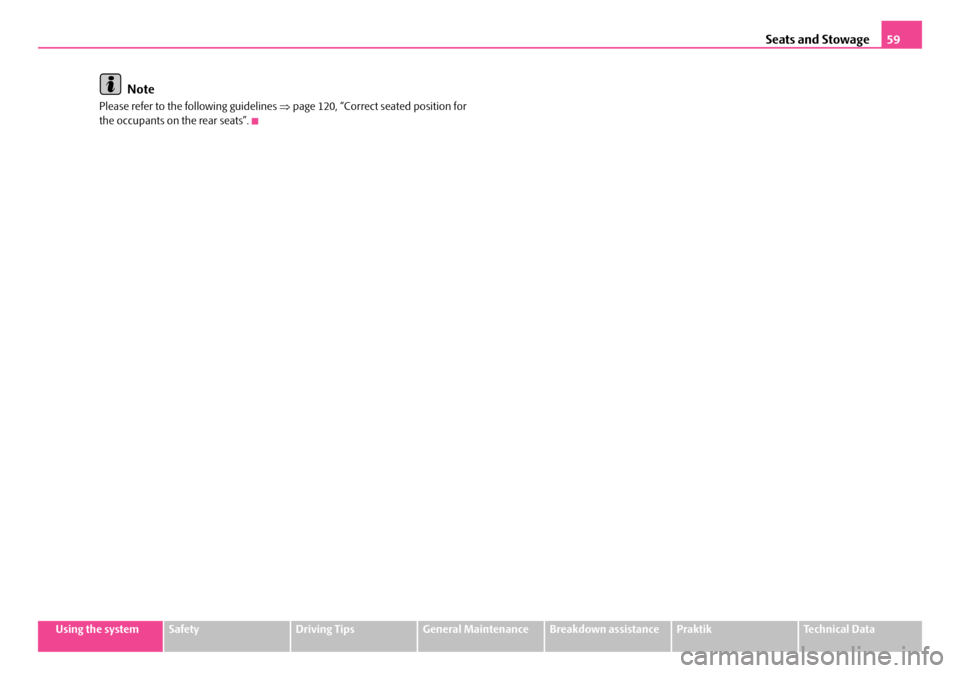
Seats and Stowage59
Using the systemSafetyDriving TipsGeneral MaintenanceBreakdown assistancePraktikTechnical Data
Note
Please refer to the following guidelines ⇒page 120, “Correct seated position for the occupants on the rear seats”.
NKO A05R 20 MR08.book Page 59 Wednesday, March 28, 2007 9:42 AM
Page 61 of 248
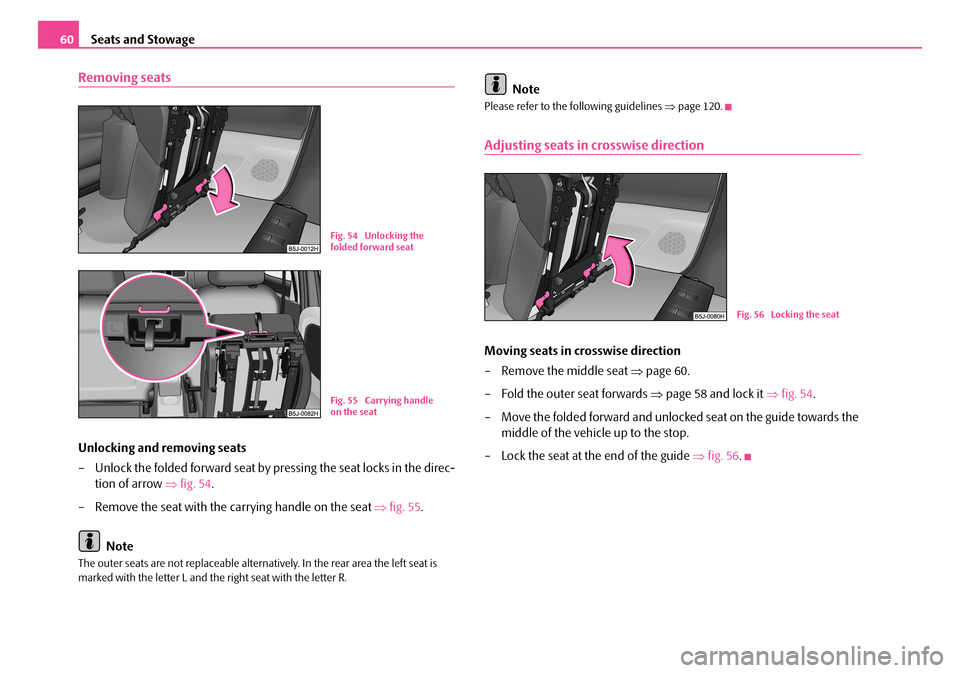
Seats and Stowage60
Removing seats
Unlocking and removing seats
– Unlock the folded forward seat by pressing the seat locks in the direc-
tion of arrow ⇒fig. 54.
– Remove the seat with the carrying handle on the seat ⇒fig. 55.
Note
The outer seats are not replaceable alternatively. In the rear area the left seat is marked with the letter L and the right seat with the letter R.
Note
Please refer to the following guidelines ⇒page 120.
Adjusting seats in crosswise direction
Moving seats in crosswise direction
– Remove the middle seat ⇒page 60.
– Fold the outer seat forwards ⇒page 58 and lock it ⇒fig. 54.
– Move the folded forward and unlocked seat on the guide towards the
middle of the vehicle up to the stop.
– Lock the seat at the end of the guide ⇒fig. 56.
Fig. 54 Unlocking the folded forward seat
Fig. 55 Carrying handle on the seat
Fig. 56 Locking the seat
NKO A05R 20 MR08.book Page 60 Wednesday, March 28, 2007 9:42 AM
Page 62 of 248
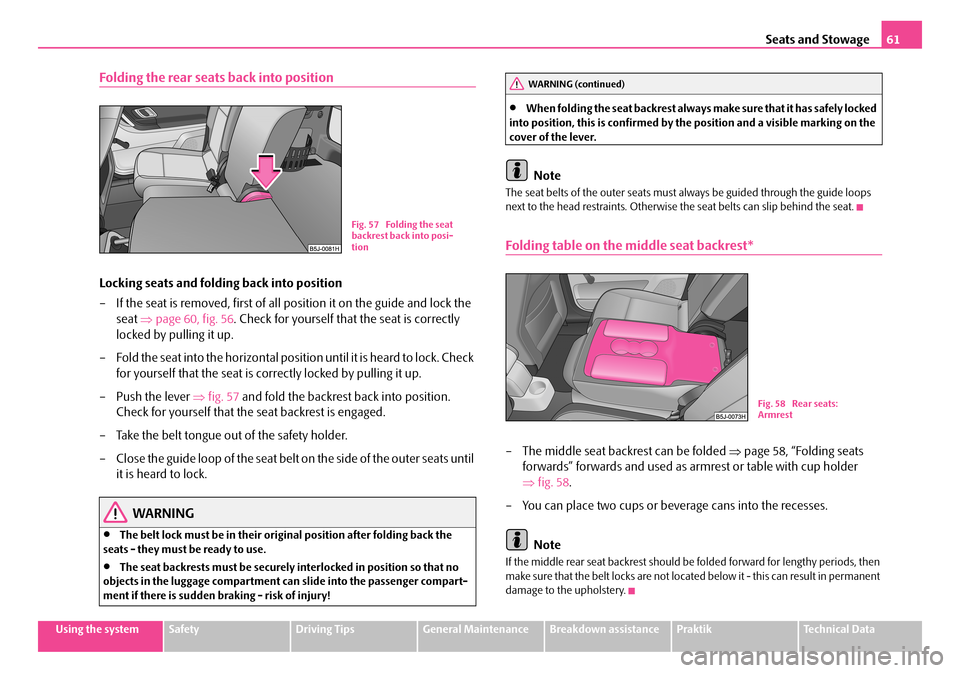
Seats and Stowage61
Using the systemSafetyDriving TipsGeneral MaintenanceBreakdown assistancePraktikTechnical Data
Folding the rear seats back into position
Locking seats and folding back into position
– If the seat is removed, first of all position it on the guide and lock the
seat ⇒page 60, fig. 56. Check for yourself that the seat is correctly
locked by pulling it up.
– Fold the seat into the horizontal posi tion until it is heard to lock. Check
for yourself that the seat is correctly locked by pulling it up.
– Push the lever ⇒fig. 57 and fold the backrest back into position.
Check for yourself that the seat backrest is engaged.
– Take the belt tongue out of the safety holder.
– C l o s e th e g u id e l o o p o f t h e s ea t b el t o n th e s i de o f t h e o u te r s e a t s u n t il
it is heard to lock.
WARNING
•The belt lock must be in their original position after folding back the seats - they must be ready to use.
•The seat backrests must be securely interlocked in position so that no objects in the luggage compartment ca n slide into the passenger compart- ment if there is sudden braking - risk of injury!
•When folding the seat back rest always make sure that it has safely locked into position, this is confirmed by the position and a visible marking on the cover of the lever.
Note
The seat belts of the outer seats must always be guided through the guide loops next to the head restraints. Otherwise the seat belts can slip behind the seat.
Folding table on the middle seat backrest*
– The middle seat backrest can be folded ⇒page 58, “Folding seats
forwards” forwards and used as armrest or table with cup holder
⇒ fig. 58.
– You can place two cups or beverage cans into the recesses.
Note
If the middle rear seat backrest should be folded forward for lengthy periods, then make sure that the belt locks are not located below it - this can result in permanent damage to the upholstery.
Fig. 57 Folding the seat backrest back into posi-tion
WARNING (continued)
Fig. 58 Rear seats: Armrest
NKO A05R 20 MR08.book Page 61 Wednesday, March 28, 2007 9:42 AM
Page 63 of 248
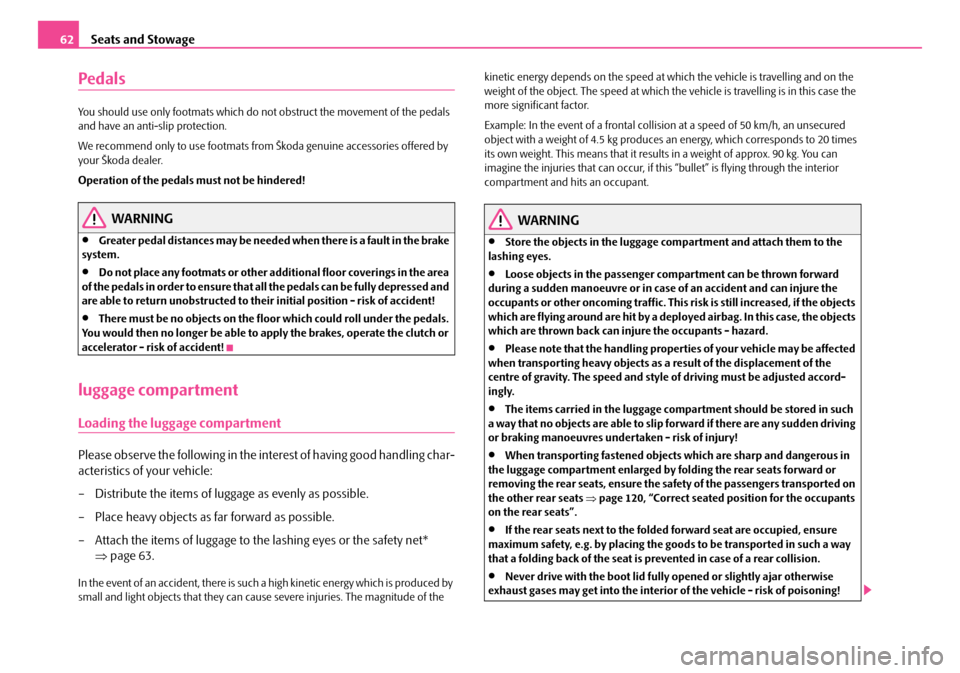
Seats and Stowage62
Pedals
You should use only footmats which do not obstruct the movement of the pedals and have an anti -slip protection.
We recommend only to use footmats from Škoda genuine accessories offered by your Škoda dealer.
Operation of the pedals must not be hindered!
WARNING
•Greater pedal distances may be needed when there is a fault in the brake system.
•Do not place any footmats or other additional floor coverings in the area of the pedals in order to ensure that all the pedals can be fully depressed and are able to return unobstructed to their initial position - risk of accident!
•There must be no objects on the floor which could roll under the pedals. You would then no longer be able to apply the brakes, operate the clutch or accelerator - risk of accident!
luggage compartment
Loading the luggage compartment
Please observe the following in the inte rest of having good handling char-
acteristics of your vehicle:
– Distribute the items of luggage as evenly as possible.
– Place heavy objects as far forward as possible.
– Attach the items of luggage to the lashing eyes or the safety net*
⇒ page 63.
In the event of an accident, there is such a high kinetic energy which is produced by small and light objects that they can caus e severe injuries. The magnitude of the
kinetic energy depends on the speed at which the vehicle is travelling and on the weight of the object. The speed at which the vehicle is travelling is in this case the more significant factor.
Example: In the event of a frontal collision at a speed of 50 km/h, an unsecured object with a weight of 4.5 kg produces an energy, which corresponds to 20 times its own weight. This means that it results in a weight of approx. 90 kg. You can imagine the injuries that can occur, if this “bullet” is flying through the interior compartment and hits an occupant.
WARNING
•Store the objects in the luggage compartment and attach them to the lashing eyes.
•Loose objects in the passenger compartment can be thrown forward during a sudden manoeuvre or in case of an accident and can injure the occupants or other oncoming traffic. This risk is still increased, if the objects which are flying around are hit by a depl oyed airbag. In this case, the objects which are thrown back can injure the occupants - hazard.
•Please note that the handling properti es of your vehicle may be affected when transporting heavy objects as a result of the displacement of the centre of gravity. The speed and style of driving must be adjusted accord- ingly.
•The items carried in the luggage compar tment should be stored in such a way that no objects are able to slip forward if there are any sudden driving or braking manoeuvres undertaken - risk of injury!
•When transporting fastened objects which are sharp and dangerous in the luggage compartment enlarged by folding the rear seats forward or removing the rear seats, ensure the safety of the passengers transported on the other rear seats ⇒page 120, “Correct seated position for the occupants on the rear seats”.
•If the rear seats next to the folded forward seat are occupied, ensure maximum safety, e.g. by placing the goods to be transported in such a way that a folding back of the seat is pr evented in case of a rear collision.
•Never drive with the boot lid fully opened or slightly ajar otherwise exhaust gases may get into the interior of the vehicle - risk of poisoning!
NKO A05R 20 MR08.book Page 62 Wednesday, March 28, 2007 9:42 AM